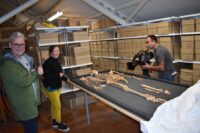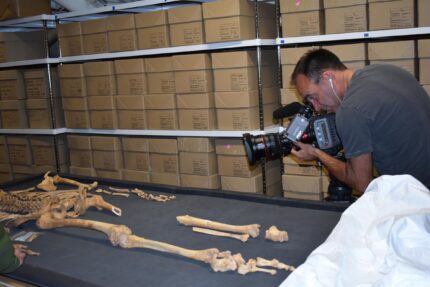 The skeleton of a Dane murdered by order of King Aethelred II in the St Brice’s Day Massacre of November 13th, 1002, will be reunited with a close family member in Denmark 1018 years after his death. The skeleton, dubbed SK1756, was unearthed in 2008 in a mass grave discovered on the grounds of Oxford University’s St John’s College. He was one of 35 males, 33 adults and two boys, who were violently murdered by an Oxford mob and buried in a pit. DNA analysis has found that SK1756 was closely related to a male skeleton recently discovered in Denmark. He was the Oxford’s victim’s uncle, nephew, grandfather, grandson or half-brother.
The skeleton of a Dane murdered by order of King Aethelred II in the St Brice’s Day Massacre of November 13th, 1002, will be reunited with a close family member in Denmark 1018 years after his death. The skeleton, dubbed SK1756, was unearthed in 2008 in a mass grave discovered on the grounds of Oxford University’s St John’s College. He was one of 35 males, 33 adults and two boys, who were violently murdered by an Oxford mob and buried in a pit. DNA analysis has found that SK1756 was closely related to a male skeleton recently discovered in Denmark. He was the Oxford’s victim’s uncle, nephew, grandfather, grandson or half-brother.
SK1756 is kept at the Oxfordshire County Council’s Museum Resource Centre. Osteological examination revealed brutal wounds. He had been bludgeoned, taking eight to 10 blows to the head, and then, presumably after he’d fallen, was stabbed repeatedly in the spine. Stable isotope analysis confirmed that the dead included people born and raised in what are now Denmark and Germany as well as some raised in the UK, consistent with contemporary reports that all Danes, raiders and settlers, men, women and children, were targets of deadly violence on Brice’s Day.
The events were reported in contemporary chronicles and official documents. The Anglo-Saxon Chronicle records that in 1002 “the king and his council agreed that tribute should be given to the fleet, and peace made with them, with the provision that they should desist from their mischief. Then sent the king to the fleet Alderman Leofsy, who at the king’s word and his council made peace with them, on condition that they received food and tribute; which they accepted, and a tribute was paid of 24,000 pounds.” Then later that same year “the king gave an order to slay all the Danes that were in England. This was accordingly done on the mass-day of St. Brice; because it was told the king, that they would beshrew him of his life, and afterwards all his council, and then have his kingdom without any resistance.”
The charter of St. Fridewide’s Priory, issued by by King Æthelred in 1004, two years after the St. Brice’s Day massacres, approvingly described the explosion of mob violence in Oxford that day:
For it is fully agreed that to all dwelling in this country it will be well known that, since a decree (decretum) was sent out by me with the counsel of my leading men and magnates, to the effect that all the Danes who had sprung up in this island, sprouting like cockle amongst the wheat, were to be destroyed by a most just extermination, and this decree was to be put into effect even as far as death, those Danes who dwelt in the afore-mentioned town [Oxford], striving to escape death, entered this sanctuary of Christ, having broken by force the doors and bolts, and resolved to make a refuge and defence for themselves therein against the people of the town and the suburbs; but when all the people in pursuit strove, forced by necessity, to drive them out, and could not, they set fire to the planks and burnt, as it seems, this church with its ornaments and its books.
The Norman chronicler Guillaume de Jumièges writing 50 years later with a notably anti-Anglo-Saxon spin contributed the Danish perspective:
But while, as we learnt above, under such a famous ruler the prosperity of Normandy grew, Æthelred, king of the English, defiled a kingdom that had long flourished under the great glory of most powerful kings with such a dreadful crime that in his own reign even the heathens judged it as a detestable, shocking deed. For in a single day he had murdered, in a sudden fury and without charging them with any crime, the Danes who lived peacefully and quite harmoniously throughout the kingdom and who did not at all fear for their lives. He ordered women to be buried up to the waists and the nipples to be torn from their breasts by ferocious mastiffs set upon them. He also gave orders to crush little children against door-posts. When thus on the appointed day this outburst of violence, death and murder accumulated beyond measure, some quick and active young men took hold of a ship and fled, speedily rowing down the Thames out into the open sea. They crossed the wide sea and finally reached the harbour they sought in Denmark, and they they reported the bloody fate of their people to King Svein. Thereupon the king, deeply moved by great sorrow, summoned the magnates of the realm, and told them what had happened. Carefully he asked their advice as to how he should act. They were all much distressed and bewailed the calamity of their friends and kinsmen and with one voice decreed that every effort should be made to seek vengeance for their blood.
SK1756’s bro could well have been part of that vengeance expedition. If so, he survived it and made it home. Next year, SK1756 will be loaned to the National Museum of Denmark in Copenhagen for a reunion with his long-lost kinsman in a new exhibition about the Vikings.

I object most strongly at your use of the word “bro” in this posting. The well-established word “relative” should have been used, not this modern slang with its sordid cultural associations.
I object most strongly at your use of the word “bro” in this posting. The well-established word “relative” should have been used, not this modern slang with its sordid cultural associations.
Bernie, I thought the same thing, but decided to ignore it in an otherwise (as usual) excellent article. However, as you have taken a stand and polarised opinion, I stand beside you on this. True, it is a minor issue; however, not just one that involves consistency of style, but a sense of propriety.
Seriously? Y’all need to chill. “Bro” has been in the vernacular for decades and has no negative connotation, but your derisive comments can only conjure division. How about a little perspective on such a tragic event, and the effort for some compensation towards good will.
Actually, “bro” is Danish “broder”, in Old Norse “bróðir”, Proto-Germanic *brōþēr.
It is also a Saxon thing: “His bróðer griþ eall æftercwæþ” (‘his brother renounced all peace’)
As every true viking knows, the term “bro” is only a particular case of a -more or less- “relative”. About his sister, we simply do not know.
:hattip:
fascinating story, great article
His name is Bernie objecting to the use of bro. Get it? Bernie bro? It’s an american politically thing.
It’s also a “tyranny of sensitivity” thing.
There is also the tyranny of tradition to consider, where we must suffer ‘real’ wood, orange pine furnishings, endless drivel about how much better it was in the past, how no one writes these days, no one can use grammar properly and so on, and so on, and so on, and on, and on, and on, and on, and on, and on, and on, and on, and on, and on…
It is our past too, and since we do not know how these people spoke, it is possible that their words indeed could have been the equivalent of ‘bro’.
So stop stealing our past, you need to share it, otherwise, come next St. Brice’s Day…
The massacre of “St. Bernie’s Day” was spawned by a the clever but ridiculous wokeness of irrelevant thought police. They spent their days inventing new definitions for words, gender, race and anything else that offended their pathetic existence…
Give it a rest bro.
Your fake outrage is tiring.
While the word ‘bro’ did seem to jolt, as much as use of the vernacular usually does in otherwise academic writings, this is a BLOG (an excellent one), not a monograph published by some lofty university. The centuries-old word ‘bro’ has been around since religious types addressed letters to others in their circles, no matter their familial relationships: Bro. Ethan, or, Bro. Harold, meaning ‘brother in the religion,’ such as monks. The word has long been used by surfers, meaning a brother in the sport, not a sibling. Fraternity brothers have used it for ages, as have soldiers who have been ‘brothers in arms’ to each other. The word ‘bro’ has been in use by speakers of English far longer than the existence of any subculture claiming it today.